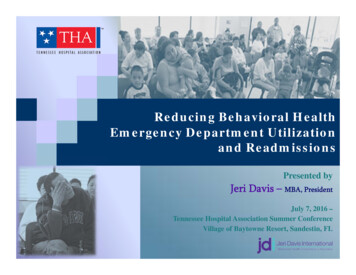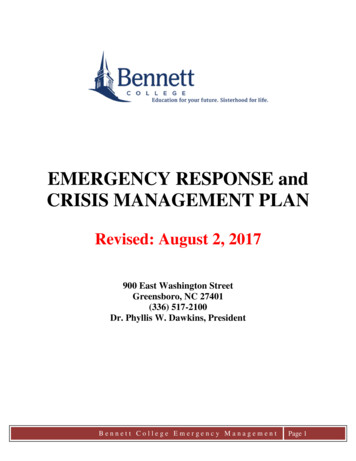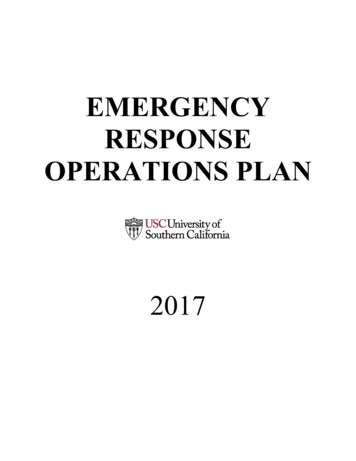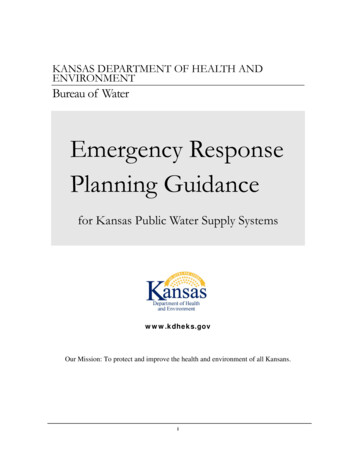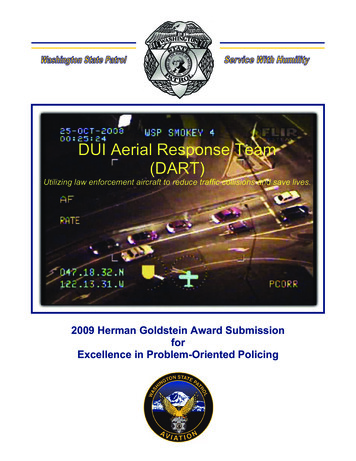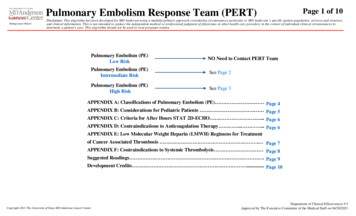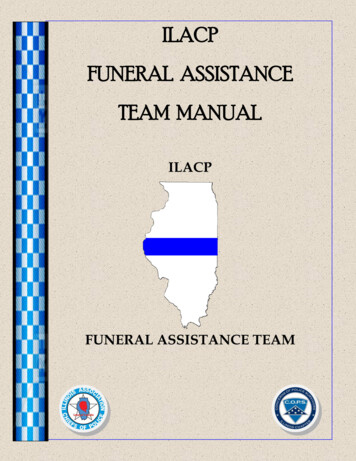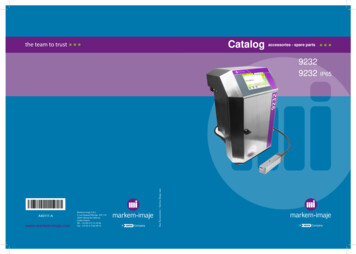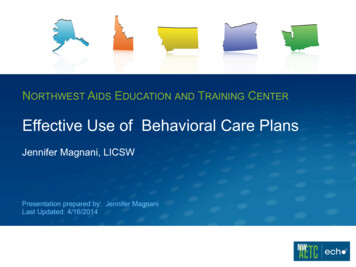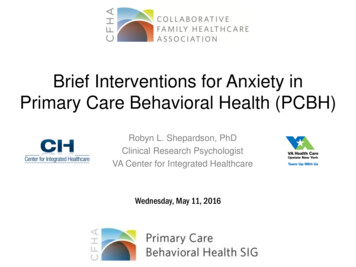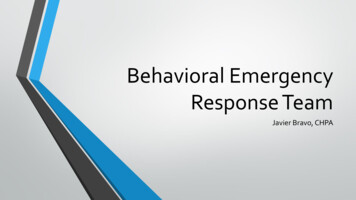
Transcription
Behavioral EmergencyResponse TeamJavier Bravo, CHPA
Why a Team In 2010, the Bureau of Labor Statistics (BLS) data reported healthcare andsocial assistance workers were the victims of approximately 11,370 assaultsby persons; a greater than 13% increase over the number of such assaultsreported in 2009. Almost 19% (i.e., 2,130) of these assaults occurred in nursing and residentialcare facilities es/violence.html
Why Cont. In 2012 the Division of Mental Health, Developmental Disabilities andSubstance Abuse Services reported 150,000 people with psychiatric needsended up in emergency departments around the state in 2012. The length of stay for the patients average about 3.5 days, or more than 3/11/08/mental-health-crisis-initiative-announced/
DEFINE the ProblemSafety of patients, staff and providers is compromised due to: Behavioral challenges presented by patients in non-Behavioral Health care areas(agitation, withdrawal, dementia, other psychiatric complications) Limited resources to prevent and manage disruptive behavior Lack of coordinated process to respond to events Staff feeling unsafe, unsupported, and poorly prepared Administration concerned with assaults on staff and major safety eventsGoal: Enhance safety of patients, staff & providers by creating: A rapid response service to assist caregivers in deescalating behaviors that threatenthe safety of the environment
Design Team Staff Psychiatrist Patient Safety Officer Nursing Administration Security Behavioral Health Intake Director Risk Manager Accreditation Specialist Quality Improvement Advisor Medical Director Behavioral Health
Guiding Principles 24/7 availability One call Immediate response Multi-disciplinary team of responders with Behavioral Health and de-escalationexpertise Continuous development based on feedback & outcome data
Education De-escalationRestraint Policies and ApplicationsInvoluntary vs VoluntaryActivation processResponsibilities of each team memberDrills
Response ProcessOngoing education with de-escalationtechniques: ongoing CPI certificationPatient behaviorescalatesCode BERT activated bycalling hospital operator;team paged overheadDe-escalationattempts by floorstaffTeam arrives to floorwithin 15 minutes(Security sooner)BehaviormanagementplanVerbal de-escalation led byBH clinicianDeveloped standardized debrief toolfor team, and to help with datacollectionMedications obtained byprimary nurse (as needed)Team debriefDeveloped agitation management power planwithin EMR; ensure meds in plan are stockedin strategic locationsHouse supervisorsround on patients dailyPt behaviorcontinues orescalates
Unit Staff Debriefing ToolComplete following each incident of behavioral/crisis management as part of staff processing.Forward this form to Performance Improvement. Do NOT place in patient chart.Date:Time: Unit: Patient:Staff members involved:Describe patient behavior and events resulting in crisis:If known, describe patient triggers (e.g., length of stay, family, bad news, etc.)Did patient have a positive ABRAT score? Yes Previous history of violence Actively hallucinating, psychosis, delirium No Not done; if not done, risks for acting out: Under influence of alcohol, chemicals Other:Were there any staff behaviors which may have contributed to patient acting out? Interventions in patient’s personal space Power struggle with patient Body language Unrealistic limits or requests Voice tone, volume, cadence Other:Was BRT activated at early stages of escalation? Yes No If not, rationale: Pt escalated without warning Did not think patient’s acting out would escalate further Did not know about BRT Other:Patient interventions attempted by staff: Calm, soothing voice Limit setting Problem solving w/ pt Was de-escalation effective? Yes NoDecreased stimuliEmpathetic listeningPRN Medications Isolating the situationOther:If not, what might be more effective next time?Did event result in restraints: None Therapeutic hold Violent restraintsPatient Injuries: None Staff Injuries: None What went well and why did it go well?Could anything have been done differently and how could it have been done differently?Is there any restitution or repair we need to make with the patient?Did patient debriefing occur? Yes No
BERT Spot SurveyMay 19, 20159.008.0053%1 - 10 4.784.744.003.002.001.000.00Sense of SafetyPre-BERTn 40Sense of SafetySince BERTTools/ResourcesDifficult BehaviorPre-BERTTools/ResourcesDifficult BehaviorSince BERT
Nursing Survey on 1st Year of BehavioralEmergency Response Team305 Responses from Nursing Staff, 70% of whom hadparticipated in a BERT call
Management of High-Risk Behavioral Health PatientsNurse Mgmt, Nurse Ed, ConsultCliniciian, PsychiatristPatient nAssessmentwith ABRATAnalysisSystemassessment& learningResiliencytraining.Green ActiveBlue PlannedOrange eNursing staff/provider deescalation effortsPtescalatesMaintenanceDe-escalationInitial Support/RLS Input/CISMContinuedescalation/safety riskSystemresponse.BERTAssault/Injury
Pt behavior escalatesDe-escalation attempts by floor staffOngoing education withde-escalation techniques:ongoing CPI certificationBehavior continues to escalateORCode BERT activated, calling511. Team paged overheadPre-BERT callHouse supervisorresponds in personTeam arrives to floor within 15minutes (Security sooner)De-escalation successful,BERT avoidedDe-escalationunsuccessfulVerbal de-escalation led byBH Clinician. Evaluate needsANDCommunicates with patient/familyRestraints if necessaryMedications obtained/administeredby primary nurse (if needed)Developed standardized debrieftool for team, and to help withdata collectionResolve & team debriefHouse supervisors round onpatient dailyDeveloped agitation managementpower plan within EMR; ensuremeds in plan are stocked instrategic locations
Further Work Integrate debriefing tool into EMR Assault support process: What happens when there is anassault on staff? Use of administrative leave Critical Incident Stress Management (CISM) Supportive neutrality on pressing charges What about the next time? Care recommendations developed by psychiatry forpatients with assaultive or violent behavior Electronic flag to alert providers to treatment planrecommendations in subsequent admission
Further Work What if they’re here for months? Supporting staff caring forbehavior problem patients long-term But we don’t have a clinician 24/7? Developing models that work for smaller hospitals Who do we have that can respond? Training for expert de-escalators? Joint training
Questions
Substance Abuse Services reported 150,000 people with psychiatric needs ended up in emergency departments around the state in 2012. . Emergency Response Team 305 Responses from Nursing Staff, 70% of whom had participated in a BERT call. Patient at - risk Nursing staff / provider de - escalation efforts Pt escalates Assessment with ABRAT Behavior management plan Continued
